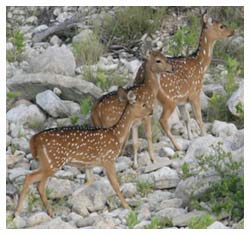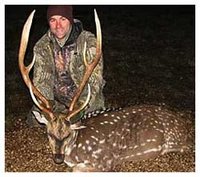Hunting Tips, Questions, Stories & Discussion
Focusing on managing Texas wildlife habitat and natural resources for native and exotic wild game species, for this and future generation of hunters and outdoor enthusiasts.Monday, June 29, 2009
What is the best way to prepare Texas Axis deer?
Regardless of how you choose to prepare Texas Axis deer meat is it important to not overcook this meat. It is best served medium to medium well, but never cooked all the way to well done. Well done venison is going to be both dry and tough, much more so than well done beef. This is largely due to the minimal fat and lack of marbling or distribution of fat through the lean muscle  tissue. Domestic animals have been bred to have fat and marbling while wild species are naturally lean and low fat.
tissue. Domestic animals have been bred to have fat and marbling while wild species are naturally lean and low fat.
What natural terrain is most favorable for hunting Texas Axis deer?
The Texas Axis deer is able to use their coloration to blend into the surroundings, especially around their favorite feeding locations. They tend to be found in the early morning and at dusk along the edge of wooden area, grazing out into open spaces. The background of the trees and wooded areas blends very well with their various shades of brown coats and the white spots further create a blending effect.
Since the nature preference for these deer is the wooded areas, feeders are typically placed just inside a clearing or along the inside edge of an opening. This natural placement of feeders encourages the natural behavior of the Texas Axis deer, but also draws them more into the open so hunters have a clearer line of sight for a shot.
Do the antlers of a Texas Axis deer grow each year or are they constantly on the bucks?
Like most deer, the Texas Axis deer bucks lose their antlers every year, according to when they were born. Every year the small buds, more specifically known as pedicels, start to grow in the spring, producing the first signs of antlers. These antlers are covered in velvet, which is rich in blood to nourish the growing cells within the antlers. When the antlers reach full size, which will vary from buck to buck, the blood supply is cut off due to hormonal changes as the rut approaches. This decrease in blood to the antlers causes the velvet to dry and the bucks rub their antlers against trees, rocks or shrubs to rid them of the old velvet.
At this point the antlers are in the best possible condition for a trophy mount. If the buck is not harvested over that season, in the winter the lack of blood to the antlers will result in a weakening of the bone structure at the skull, causing the antlers to actually fall off and the cycle to start again.
Labels: axis deer recipes, axis doe hunting, texas axis deer
Sunday, January 4, 2009
How are the Axis deer managed on a hunting ranch like Escondido?
 On a large managed hunting ranch such as the Escondido Ranch there are literally hundreds of acres of natural habitat for the deer population. This allows the herds to live as they would in wild settings, breeding year round and producing abundant crops of healthy fawns. Since the mating seasons are not restricted or controlled by man, the deer population is kept at peak levels year round.
On a large managed hunting ranch such as the Escondido Ranch there are literally hundreds of acres of natural habitat for the deer population. This allows the herds to live as they would in wild settings, breeding year round and producing abundant crops of healthy fawns. Since the mating seasons are not restricted or controlled by man, the deer population is kept at peak levels year round.Finally the managers of the ranch are aware of how many bucks and does are harvested by hunters, allowing the range to avoid over grazing or removing too many breeding adults from the population. In years where there are fewer or more fawns produced, managers are then able to make determinations as to the number of adults that can be harvested to keep the population stable.
What is the hunting season for Axis deer?
Typical deer season in Texas runs from close to the end of November until the first month of the New Year in January. While there are lots of whitetails around and they provide great hunting, the season is very time restrictive plus you have to have permission to hunt on private property, making it tough unless you know a local rancher. Of course you can also book a hunting trip on a private hunting ranch, but you still have to say within the season.
Unlike native hunting species, the Axis deer is considered an exotic animal. As such there is no prescribed legal hunting season for the species within the state of Texas. This means that hunters can extend their hunting season through booking with a private hunting ranch. Many hunters choose to hunt Axis deer in the summer when some of the largest antlered bucks are harvested and hunting pressure is minimal.
Labels: axis deer hunting, exotic deer hunts, texas axis deer
Archives
December 2008 January 2009 February 2009 April 2009 May 2009 June 2009 July 2009 August 2009 September 2009 November 2009 December 2009 January 2010 February 2010 March 2010 April 2010
Subscribe to Posts [Atom]
